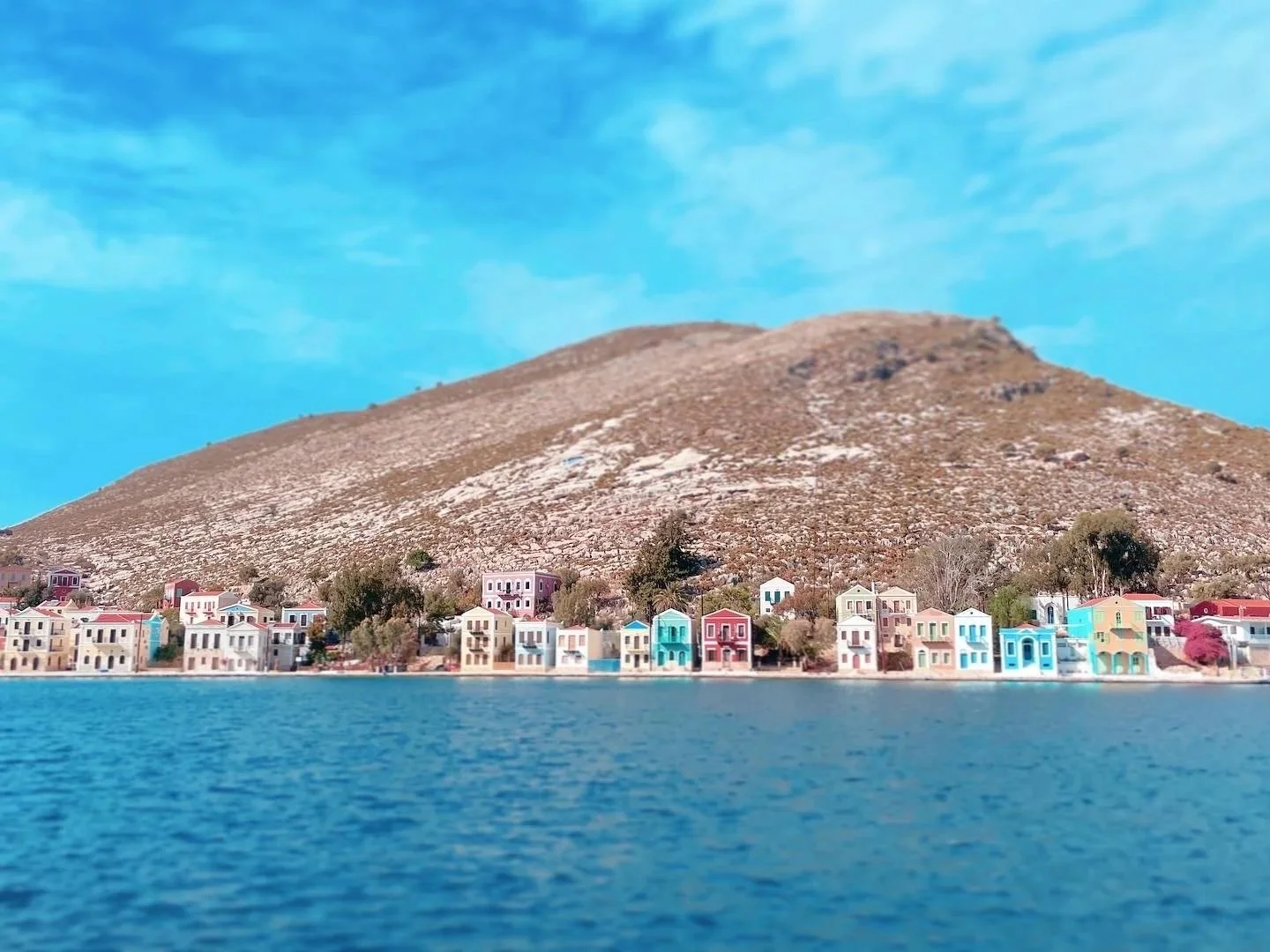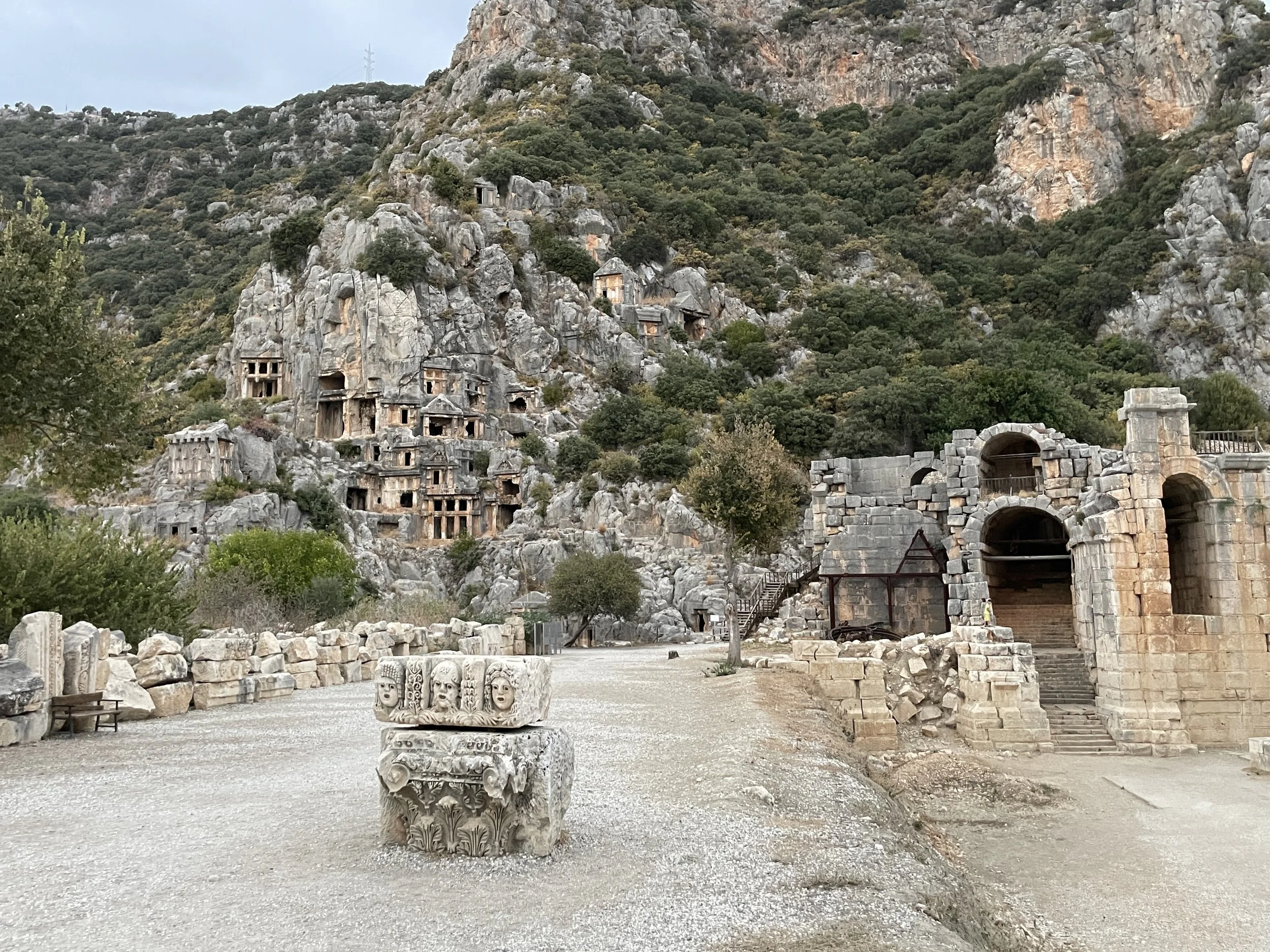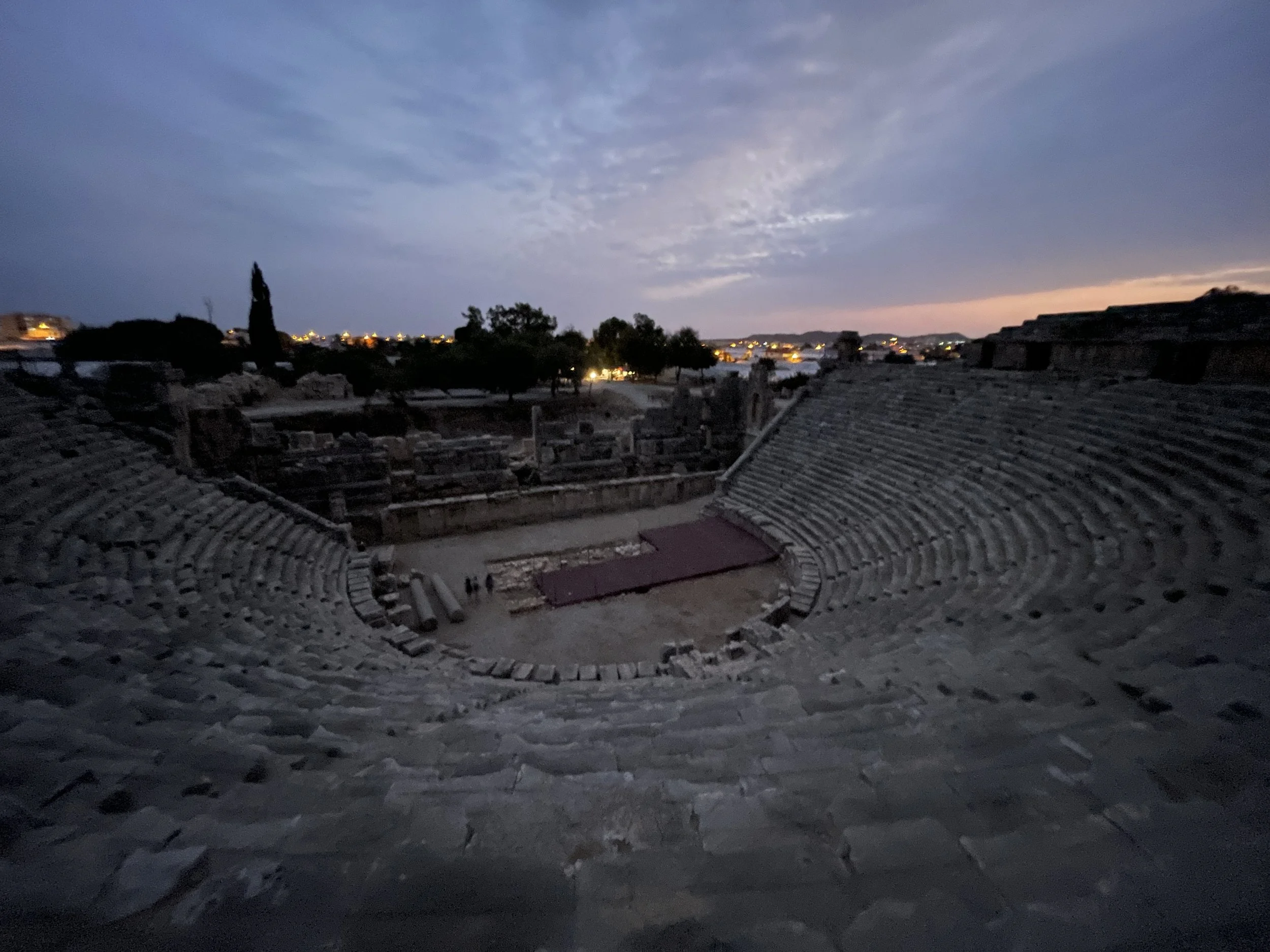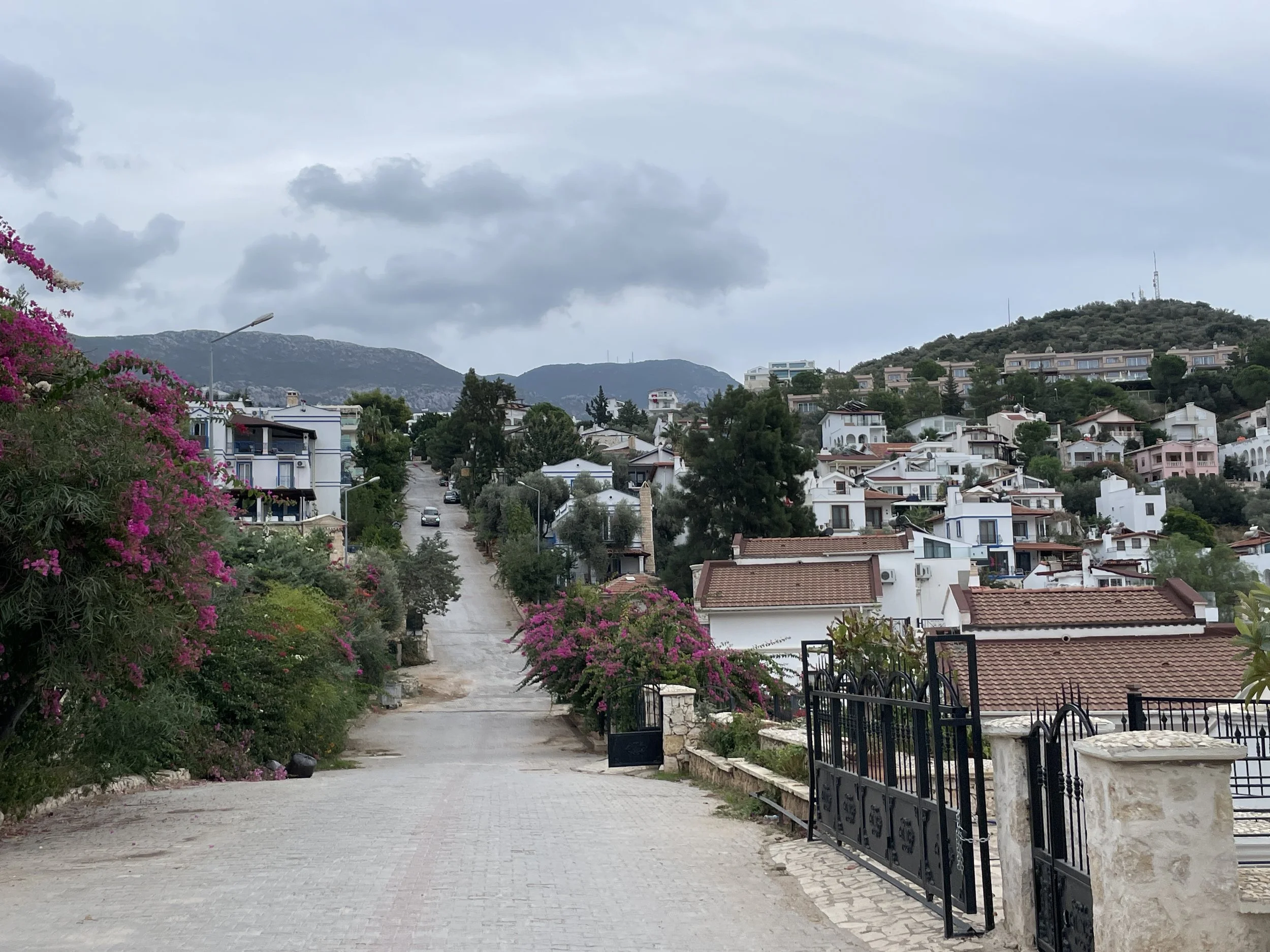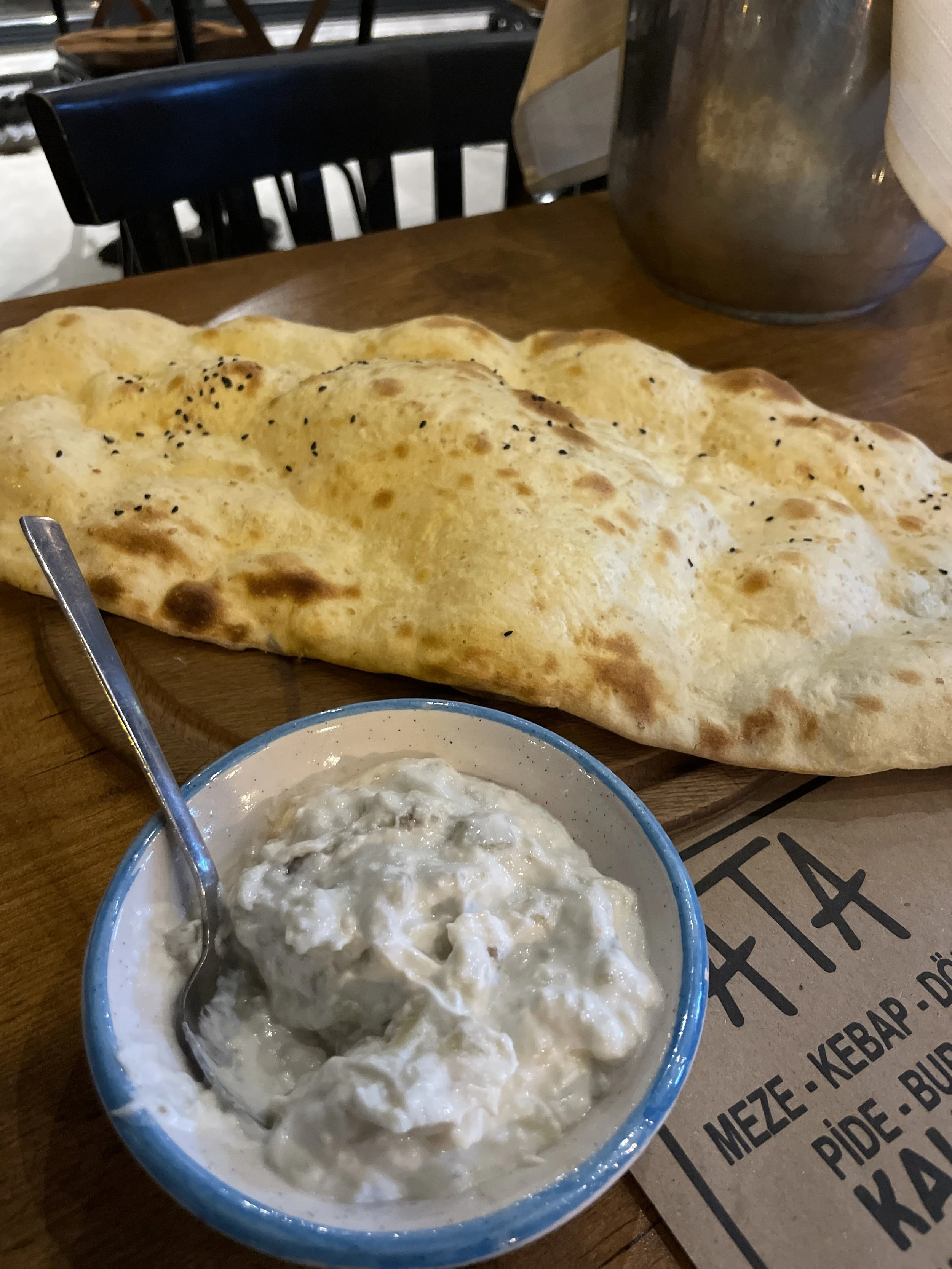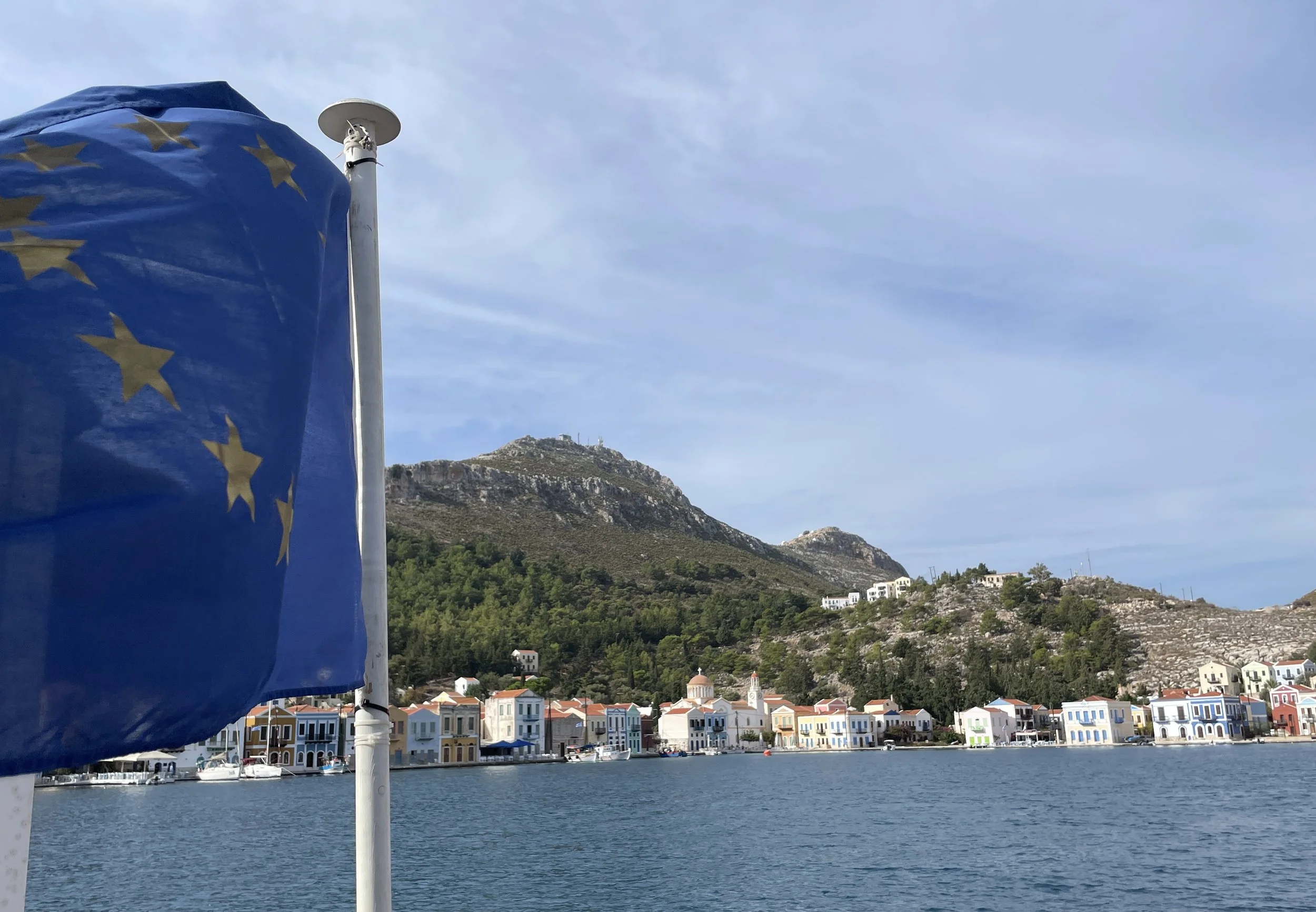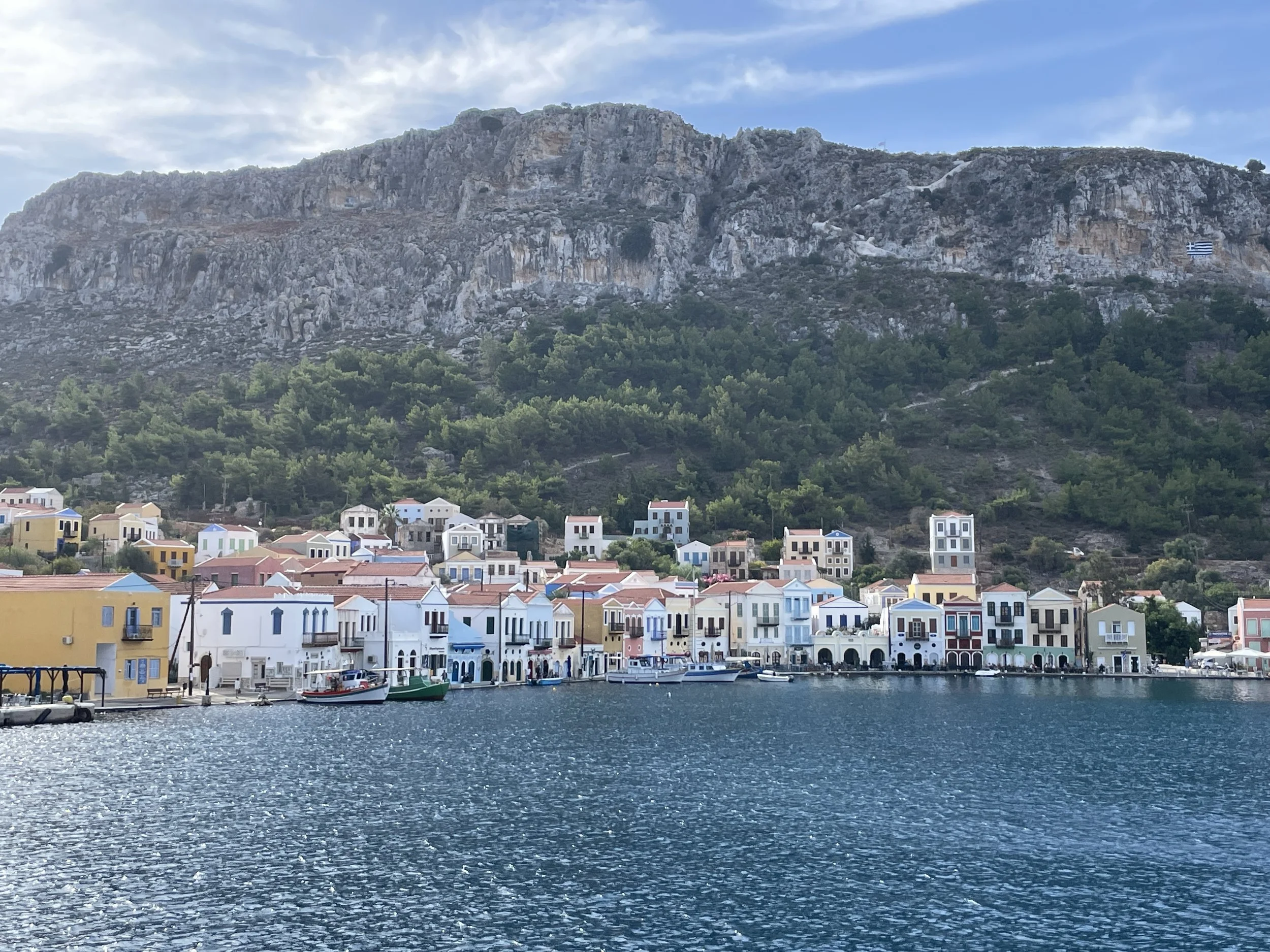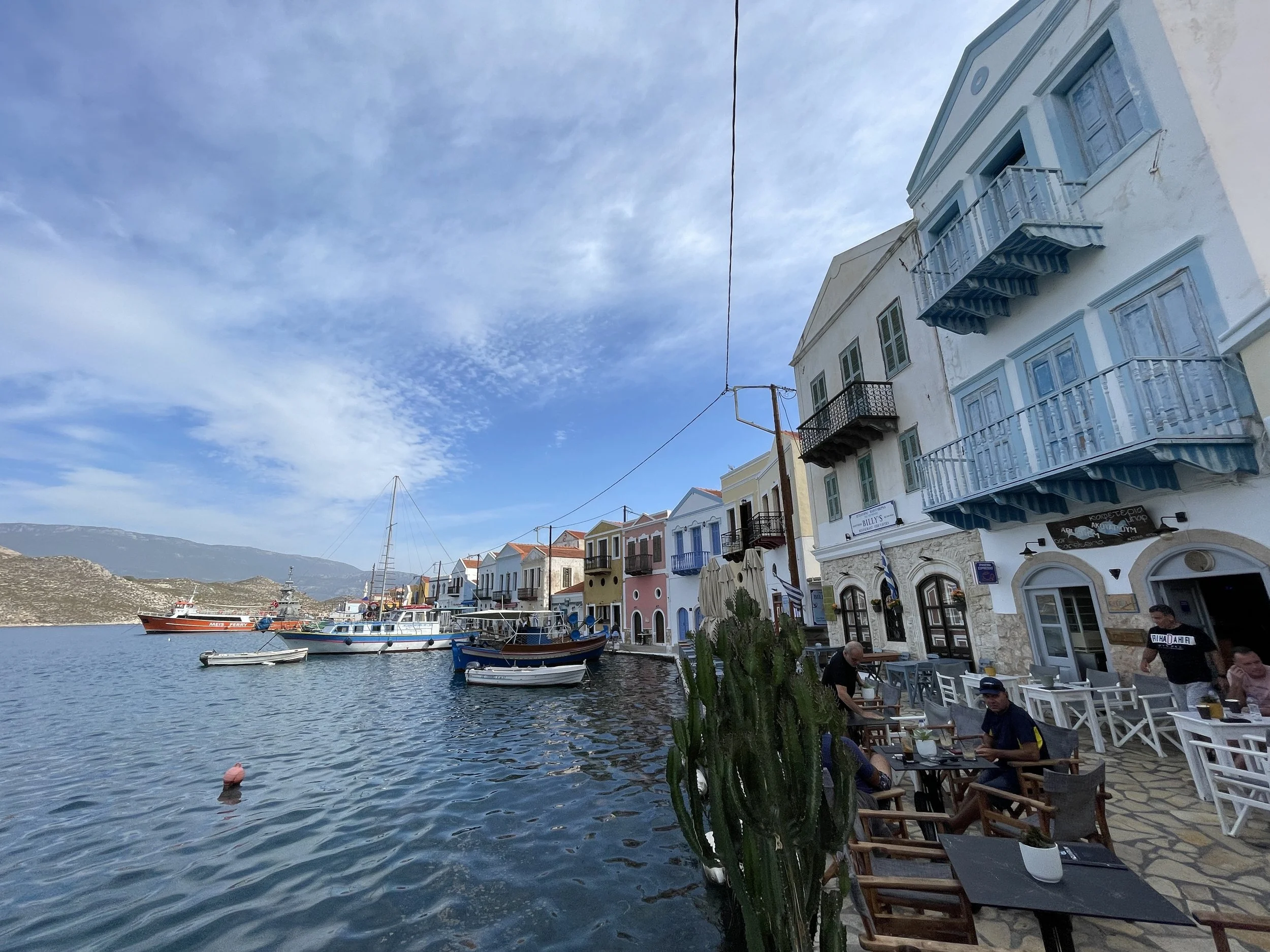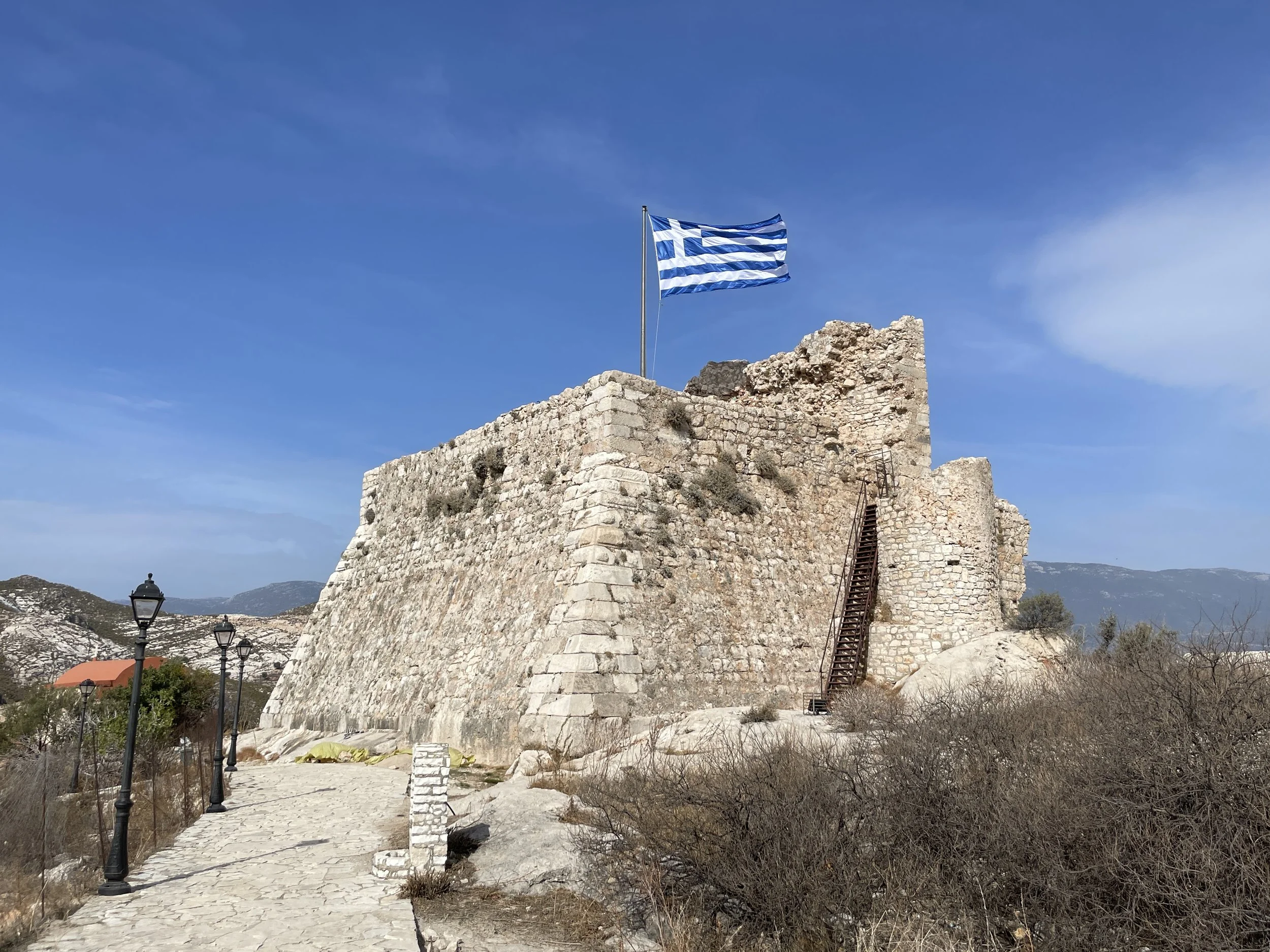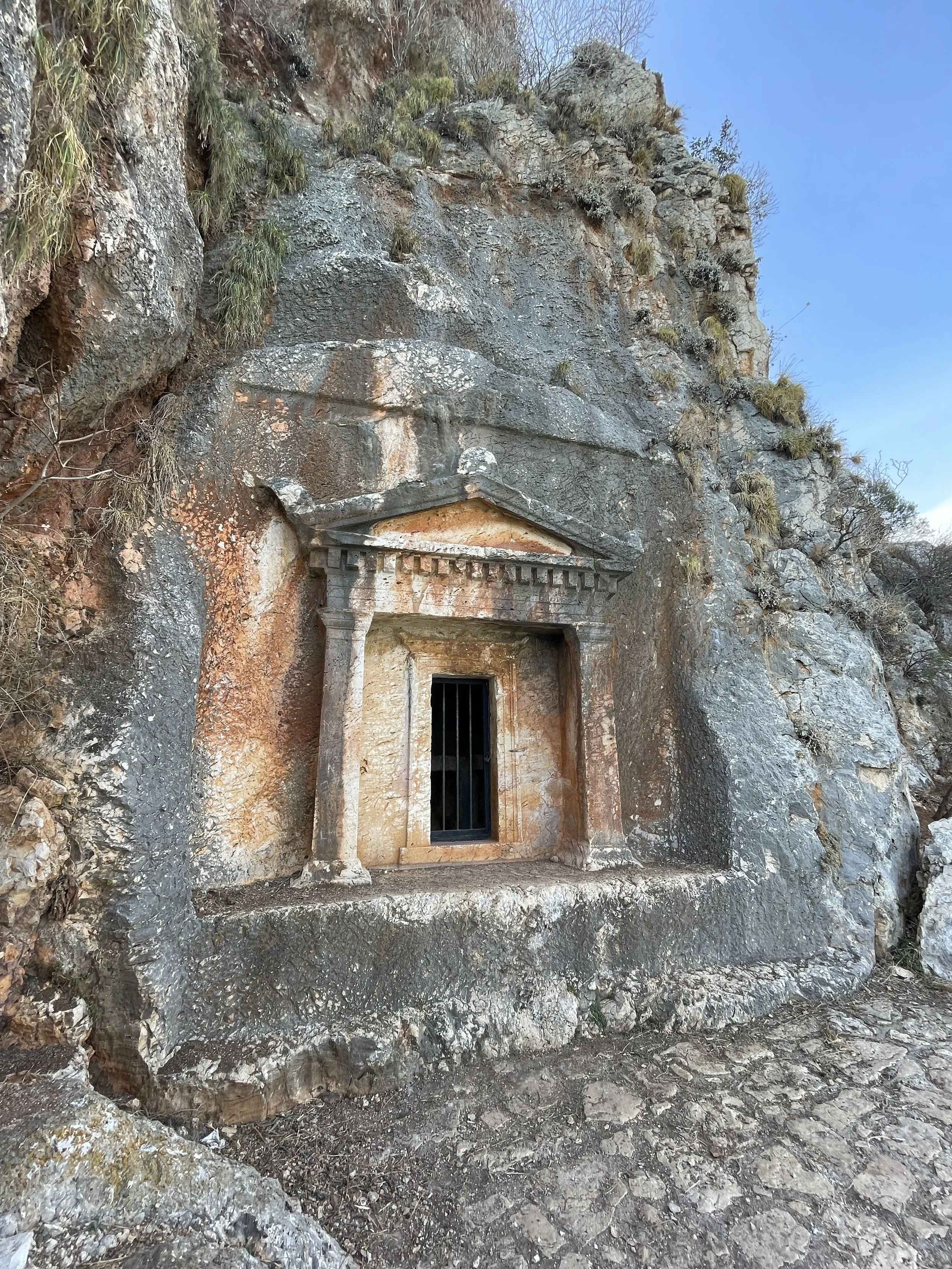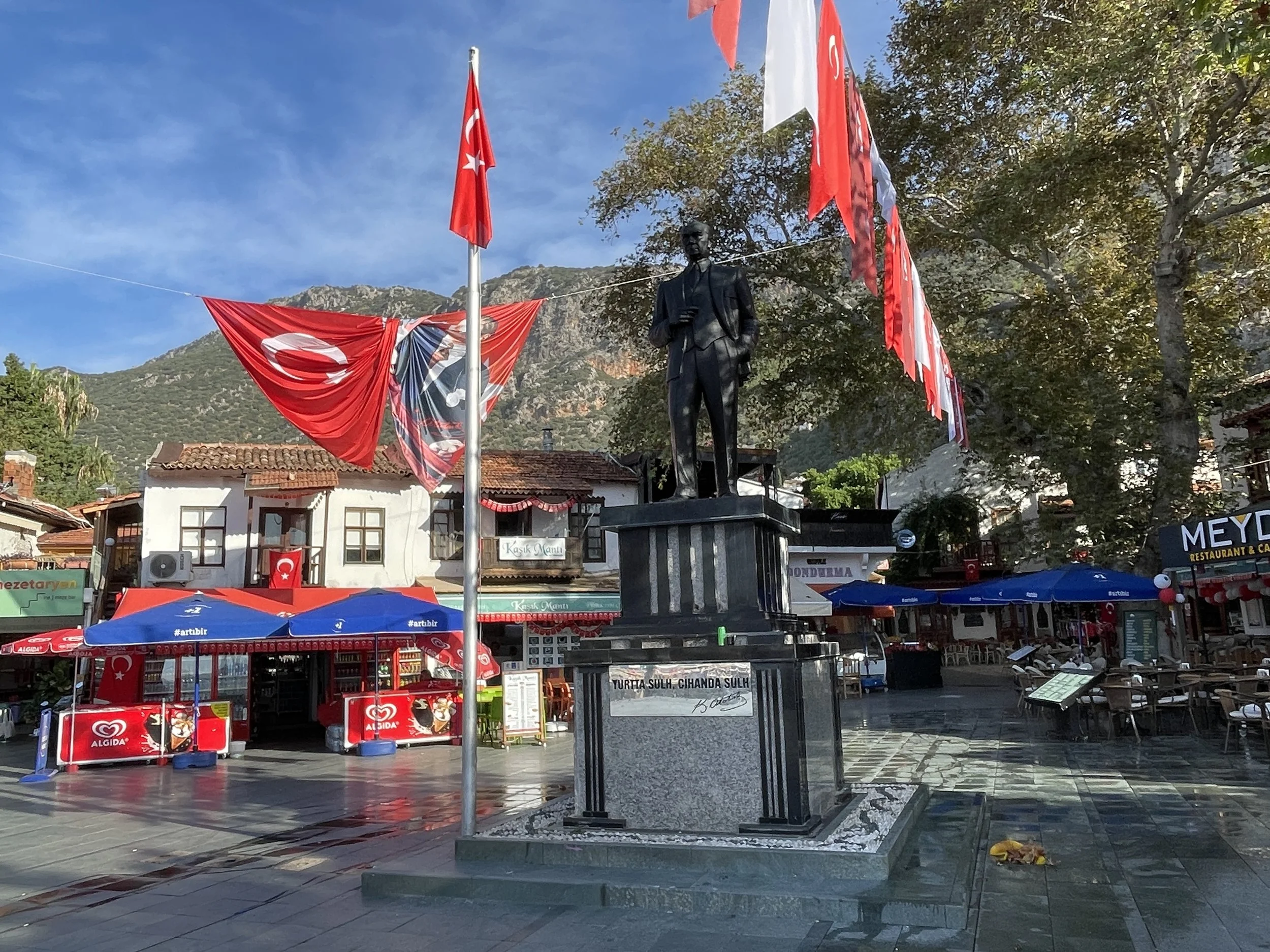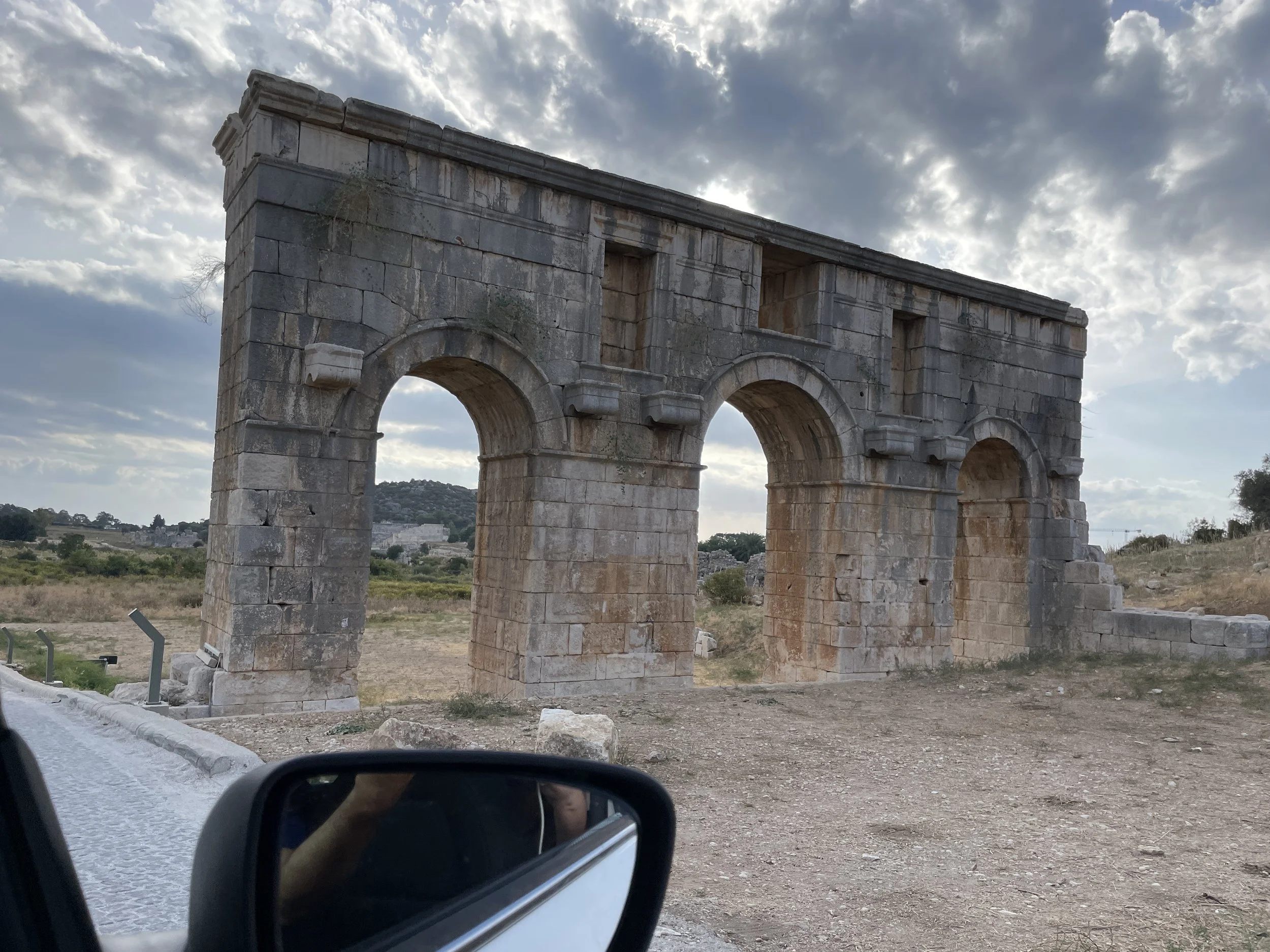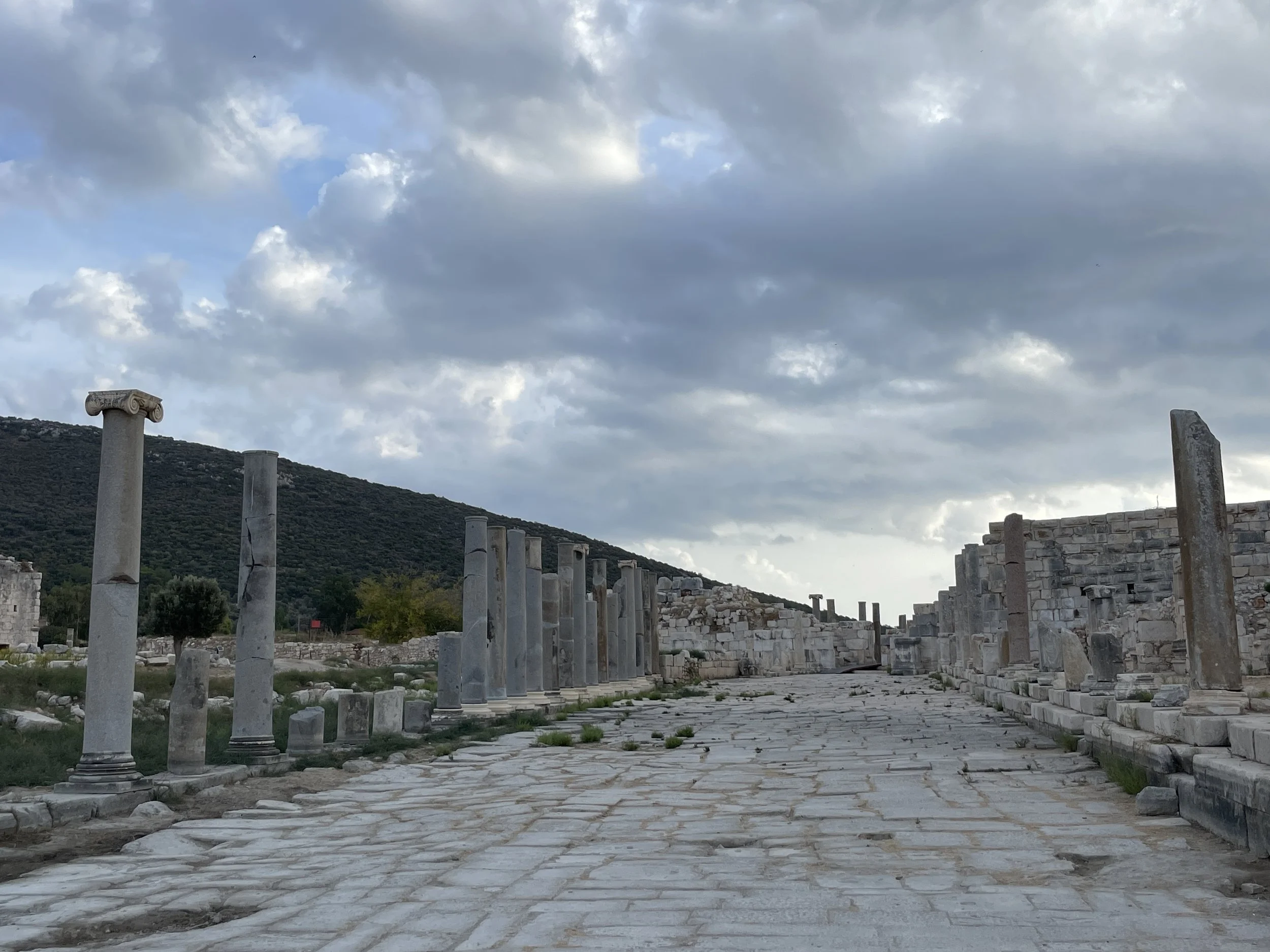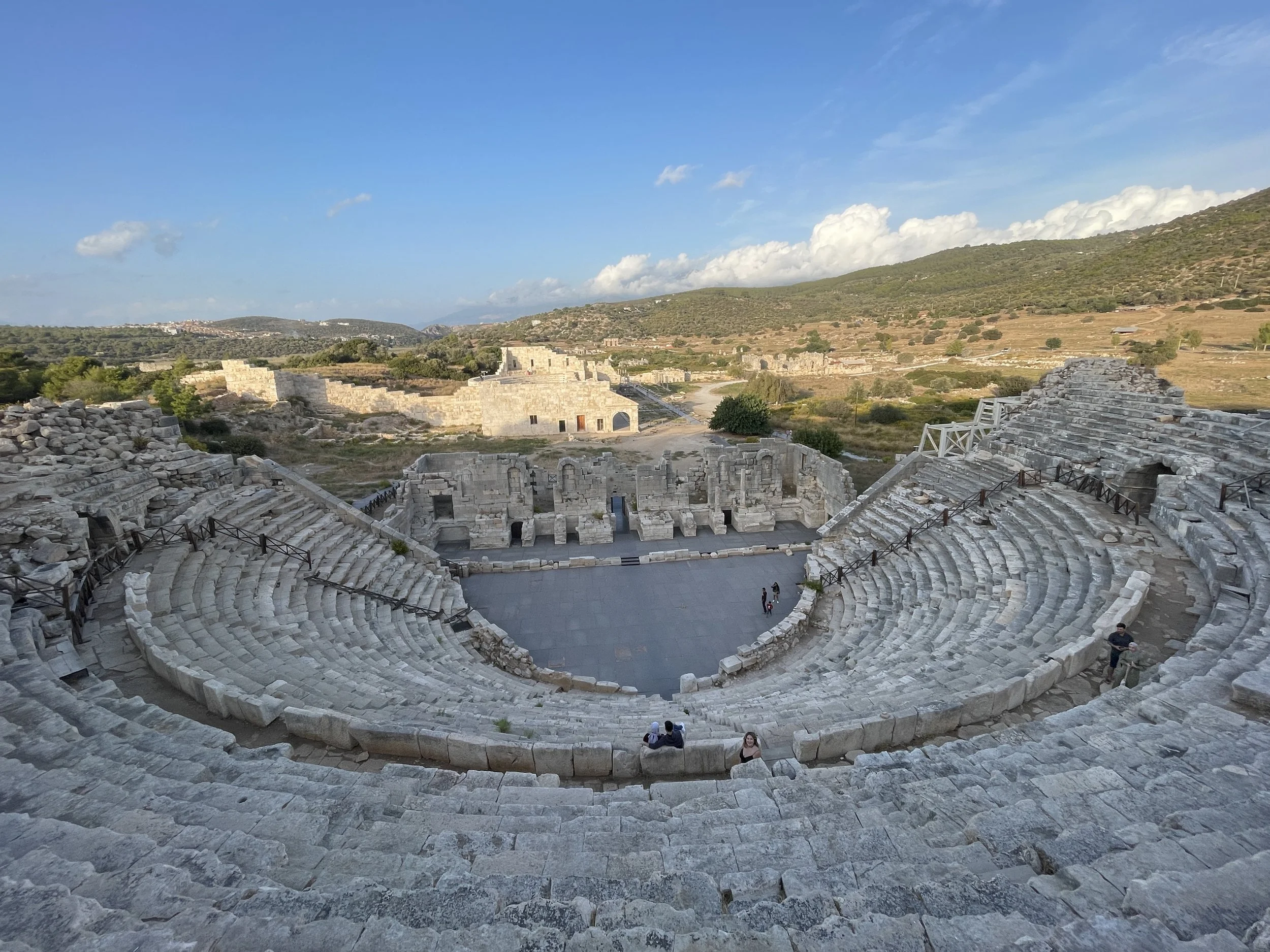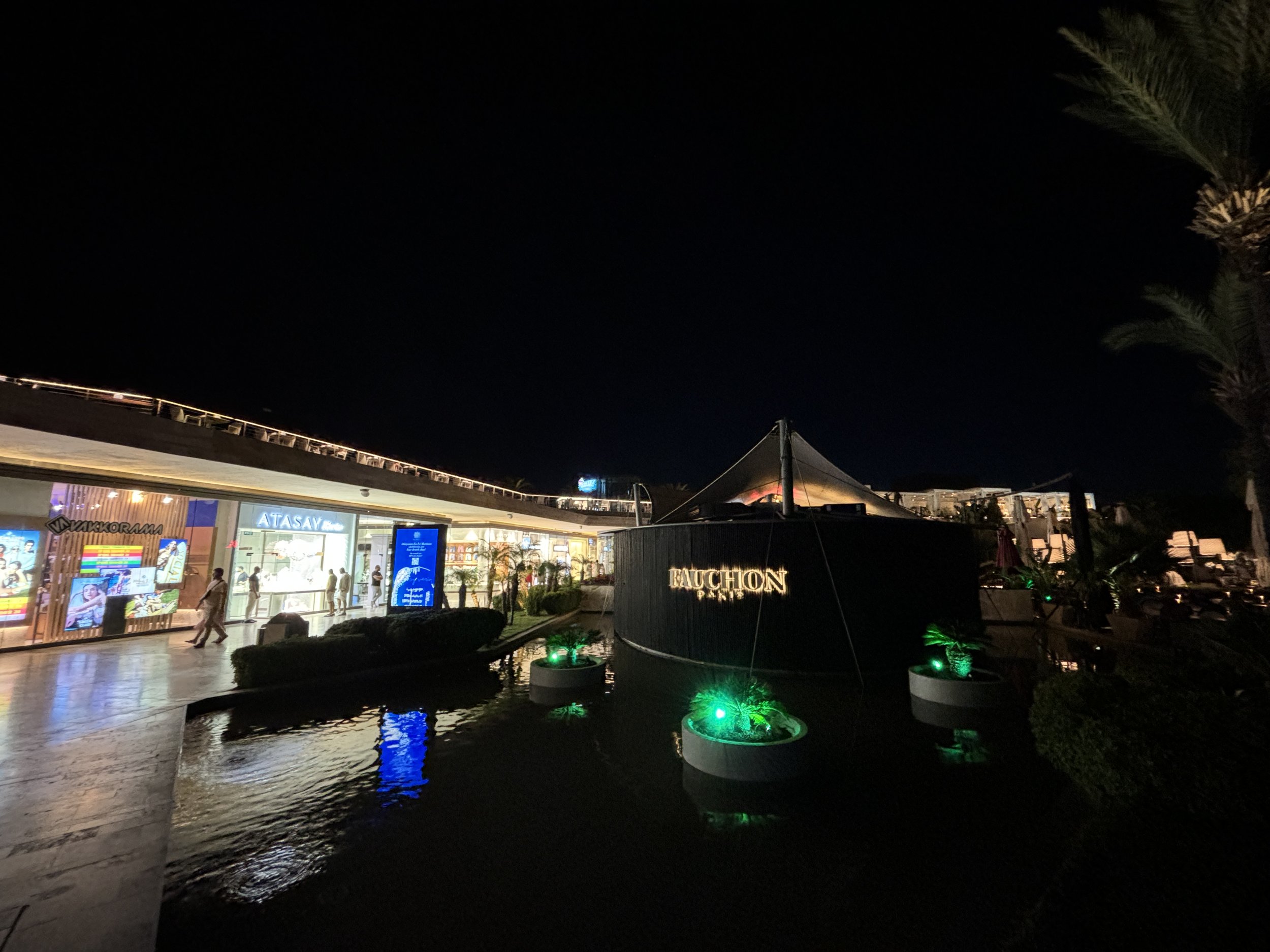Kaş to Kastellorizo: where Turkey's Lycian Way meets the most distant Greek island
This post covers one of the areas with, possibly, more top historical heritage per square kilometre of the Mediterranean and this is on top of a stunningly beautiful landscapes.
This is, of course, not our first foray to the Turkish Aegean coast, you can also check our post about what to see in Bodrum and its surroundings. This one covers another section of the beautiful and rugged coastline of southwestern Turkey, particularly the area around Kaş and Kalkan and the neighbouring Ancient cities of Myra and Patara, what is today known as the “Lycian Way”.
What’s more, for those like me, who are interested in borders and those places that act as fault lines (or meeting points, depending on how you see it) between countries, continents and cultures, this region contains a particularly interesting spot: a very tiny Greek island which is really far away from the mainland, but almost adjacent to the nearby Turkish coast.
Keep on reading to find out how is it like to visit this tiny Greek (and European Union) outpost from the neighbouring Turkish town of Kaş.
Getting to the Lycian Way
Let’s start with a short paragraph about logistics. It’s going to be short: rent a car.
The area of Kaş is located roughly halfway between Antalya and Dalaman airports (Bodrum is also a reasonably close gateway and gets more flights than Dalaman). There is no train connection and I don’t think buses are a practical option to move along the area. I know “walking the Lycian Way” is a thing, but since this is not a hardcore trekking site, I will leave this one out too.
This leaves renting a car as the most convenient option and, actually, the roads are generally ok (between Antalya and Kaş about half of the distance is actually covered by a two-lane motorway). I also found parking in those coastal towns surprisingly easy (particularly when compared with its equivalents in Western Europe), but this may be due to the fact that my trip was in the autumn, and, therefore, a bit off season.
The Ancient city of Myra - the city of Santa Claus!
One the way between Antalya and Kaş perhaps the most fascinating place you can visit is the Ancient Lycian city of Myra.
The Ancient city of Myra (“Myra Antik Kenti” in Turkish) is a truly interesting spot for several reasons:
It was one of the epicenters of the Lycian civilization, which used to be kind of part of the Greek world, but not quite. Lycia had, in fact, its own cultural and political system for quite a few centuries, until the Romans took over the whole region and made it part of their Empire. Lycian cities were organized in a league that had some proto-democratic elements in the way it worked. It was actually mentioned by Montesquieu and said to have inspired the US Founding Fathers, as well.
Myra was the home city of Saint Nicholas (aka Santa Claus). Although he was born in Patara (another Lycian city that we also cover, further down this post, Saint Nicholas was the bishop of Myra for some time in the 4th C. There is a church of Saint Nicholas in the Ancient city, which is visited by numerous pilgrims (Saint Nicholas is said to have been buried there at first, but in the Middle Ages his relics were taken to Bari, in southern Italy).
The archaeological ensemble of Myra is absolutely stunning. Its most famous landmark are the rock-carved tumbs that fill the surrounding cliffs. These have porticos and facades, creating the impression of a proper city carved in the face of the rock. Next to it are the vestiges of what was, in its time, a rather important city, complete with a very well preserved theatre and many of the buildings that we typically associated with the major cities of Antiquity.
So, make sure you include a visit to the Ancient city of Myra in your itinerary!
Kalkan, perfect base for exploring the coast around Kaş: where to stay and eat
Our hotel recommendation in Kalkan:
Payava Hotel
Kalkan, Cumhuriyet Cd. No:80, 07960 Kalkan (Kaş)
This little hotel in Kalkan, a town some 27km west of downtown Kaş, was a real find. We booked it at the very last minute and it totally surpassed expectations.
The facility is on the outskirts of Kalkan, but if you have a car this is not an issue. It is actually quite easy to get there and to park (the hotel has its own private parking space).
The facilities are pretty modern (the bathroom in particular was pretty large) and, while not exactly next to the sea, it does have views of the sea, as well as a swimming pool with terrace.
I would also like to highlight the service, which was excellent. The hotel staff were actually very friendly throughout. At the end, we decided extend our stay for one more day than originally planned!
While we did not have lunch or dinner at the hotel, since we spent most of the day on excursions or exploring downtown Kalkan (see the section about where to eat in Kalkan further below), we did try the hotel’s breakfast and it was absolutely great.
The breakfast buffet at Hotel Payava offered a broad mix of European and Turkish foods (including an amazing assortment of local cheeses) as well as plenty of fresh fruit and produce.
Great place to eat in Kalcan
Ata Mezze Grill
Kalkan, Şehitler Cd. no:21, 07960 Kalcan (Kaş)
This is not the fanciest or the most expensive restaurant in Kalkan, but it is the one I would go back to without hesitation!
It is actually a kebab and mezze place located a bit in the outskirts but within walking distance of downtown.
The vibe of the place was nice, the food super tasty and the prices, very reasonable. We also got excellent service.
Here are some pics of the assortment of Turkish kebabs, bread and sides that we got (note also the paper tablecloth with the map of the Lycian coast, I really like restaurants that do this!)
The kebabs are all prepared in proper charcoal and served in generous portions, so top marks for this. But even better was this traditional Turkish dessert called “Katmer” (see below), which is simply amazing!
Katmer combines Kaymak (Turkish-style clotted cream) with a thick and sweet pistaccio paste encased in a sort of mille-feuille. It is served warm and waiter breaks the outer crusty shell when serving it. Delicious!
A day trip to Kastelorizo from Kaş
As mentioned in the opening section of this post, one of the attractions of the Kaş area, at least for those like me that are interested in borders and geopolitical boundaries, is the possibility of visiting the Greek island that is most distant from its mainland and which is also one of the EU’s tiniest and most peripheral outposts as well: the island of Kastellorizo (Megisti in Greek).
Kastellorizo is a tiny island, roughly 9km at its longest point and 2km at its widest, with some 500 permanent inhabitants. It is distant about 1 mile from the Turkish coast but some 100 miles or so from the closest Greek island, Rhodes. Kastellorizo also has a number of adjacent islets and rocks that are also under Greek sovereignty.
Considering the usually tense relations between Greece and Turkey, it will possibly not come as a surprise to you that this island has been a flashpoint in the long going disputes between the two countries. Recently, for example, Greece and Turkey quarrelled about the limits of their respective Exclusive Economic Zones (EEZ) in this part of the Mediterranean.
In an attempt to diffuse these tensions and to promote the good understanding between the two countries, a number of people in this region came up with the idea to organize an international sports event linking Kastellorizo and Kas in a friendly manner.
The result was the Kastellorizo-Kaş international swim, which takes place every year in June.
Participants swim across the narrow strait that separates Kastellorizo from Kas. It is technically a competition, but takes place in an atmosphere of friendliness and cooperation, since the main goal is to foster good cross-border relations.
I really don’t know when and how the border formalities are conducted, though, since Kastellorizo, as part of Greece is EU territory and is within the Schengen zone, so people making the crossing in that direction must have the proper paperwork to enter the EU. Likewise, the Turkish Republic enforces passport controls on its borders and this applies to the short hop from Kastellorizo too.
How to get from Kaş to Kastellorizo?
The easiest and shortest way is to take the ferry (operated by Meis Express) from the small port of Kaş, from where several ferries depart every day (the island has also ferry service to Rhodes, although it takes several hours on account of the much longer distance. There is also a small airport in Kastellorizo with to Rhodes, as well).
It is possible to buy tickets at the port terminal in Kaş , although it is best to book them online in advance.
The island, which can be seen from the shore, is just a 20 minute ride away. The ferry ride can, in itself be quite a pleasant experience if the weather is nice. There is an open terrace (as well as an indoors cabin) which is perfect to enjoy the sights of the coastline and the blue waters all around. We did even get to see some flying fish following us and jumping out of the water all around the boat!
Halfway to Kastellorizo, the boat crosses the international divide the Greek flag is raised (the boat is Turkish). On the return trip, the inverse operation is performed, with the flag being lowered down.
The existence of the border is very present throughout. In fact the first thing you notice when you sail into Kastellorizo’s beautiful small sheltered harbour are the huge flags of Greece (painted on one of the island’s hills) and of the European Union (waving at the entrance of the port), which welcome you to the island.
Besides the border control upon arrival, the liminal nature of this place is also accentuated by some other small details that you don’t need to be a border geek to notice. For example, you switch from Turkish to Greek time (-1h), from Turkish Lira to Euro and, if you have a EU sim card, you get to benefit from the roaming-charge-free mobile connectivity.
Exploring Kastellorizo
The island of Kastellorizo is absolutely beautiful and it would be well worth a visit even if you are not interested in all this border stuff. Most of the island’s population cluster around a tiny, almost perfectly quadrangular harbour bay, which is lined with cute traditional houses painted in an array of bright, vivid colours.
So, what to do in Kastelorizo once you set foot on the island?
Unless you have decided to overnight on the island, your time is likely going to be constrained by the ferrys’ schedule. It really depends on the time of the season and of the week.
When we visited the last ferry departed back for Turkish territory at around 5pm. So, this gave us around 6 hours on the island, which, I think, is enough to explore its main town and its surroundings and get a decent meal at one of the many restaurants lining the harbour.
So, what most people do is just go for a relaxed stroll along the harbour and the handful of streets around the historical center. These are really nice and encapsulate a certain idea of the Mediterranean as many people imagine it.
The seaside promenade is a bit touristicized, though (which I guess is inevitable in this setting!) and the different restaurants compete very proactively for the daily haul of tourists arriving in the ferrry.
Yes, it can feel a bit touristy and prices are not particularly cheap, but I would still include a seaside lunch in the Kastellorizo experience, if only because there is not “that much” to do once you have taken your nice postcard-like pictures!
You may also see the sea turtles that roam around the harbour. They are obviously used to human presence, since many of the tourists feed them scraps of food and even some restaurant owners do the same in order to attract them to their section of the harbour for the entertainment of their guests.
The other thing I would recommend doing, if you don’t mind the steep walk, is climbing up to Kastellorizo’s castle.
While the fortress is now in ruins, it commands quite a great viewpoint, dominating the harbour below. It is not a surprise that this place has a long history and it is suspected to have been fortified already in Antiquity.
The heyday of this fortress, however, was during the Middle Ages, when it was occupied by the Knights of Saint John and even, for a few decades in the second half of the 15th C., by a Catalan warlord, Bernat I of Vilamarí. I had read somewhere that it was still possible to see the four stripes of the House of Barcelona carved on one of the stones, but I could not find them (in fact, the castle is in such a state of ruin that it is only possible to access what is left of one of the towers). The island got even a Catalan name during that period “Castellroig”.
In 1512 Kastellorizo was taken by the Ottomas and in successive centuries it changed hands several times between Venetians, Greeks, Turks, Italians, and even British and Germans during WW2. In 1947, together with the other Dodecanese islands, Kastellorizo was confirmed as part of Greece.
From the castle you can also enjoy great views of the Lycian coast and the several little islands and islets that dot this area. But there is more…
If you climb down the castle hill by taking a little trail on its sea-facing side you will come across a couple of rock-carved monumental Lycian tombs, quite similar to the ones found in the Ancient city of Myra. This seems to have been a cultural practice common all over this region.
Btw, you can also continue along the seaside path to get additional views of the entrance of Kastellorizo’s harbour as you walk back to the ferry terminal.
Once back on Turkish soil, you can also spend some time exploring Kaş downtown.
While it is mostly a modern town, Kaş is actually, quite a lively place, with plenty of shops, cafés and commercial activity going around.
Visiting the Ancient city of Patara (the birthplace of Santa Claus!)
And, last but not least, if staying in the Kaş area, the Ancient Lycian city of Patara is another must-see, since it is located just a few miles west of Kalkan.
We have already commented on Myra, the city where Saint Nicholas (Santa Claus) served as a bishop, but, in fact, Patara was his birthplace.
Patara was quite a sizeable city at its peak, and even if only a small part of its perimeter has been excavated you can get an idea of its importance.
There are quite a few magnificent Ancient monuments in Patara, such as this impressive and well-preserved theater. What’s more, the ruins of the Ancient city are located right next to a long sandy beach, so it is perfectly possible to combine a visit to the archaeological site with a swim in the Mediterranean (and I would actually recommend doing so!).
Some of the top things to do and to see around Bodrum
Bodrum is one of the most popular destinations in the Turkish Aegean riviera, and of the whole Mediterranean basin. So, there is no shortage of information out there.
Therefore, what I will try to do here is to share my personal experience visiting some spots in the area which I think can be of interest, particulatly if you are looking for something more than just tanning by the beach (for the record, I did spend a considerable amount of time at the beach or poolside too!).
Before moving ahead, let me clarify that I have used the word “Bodrum” here to refer to the whole peninsula where this city is located. I think this is in line with how most people use this place name, since the points of interest and the related tourist infrastructure is spread out over a rather large area.
Another important point: if you wish to move around the area is best to rent a car. Roads can vary in quality, some are pretty good, like the one to and from the airport, but secondary ones can be a bit more tricky and signage is often lacking. It is overall manageable, though, best to carry a phone with interenet connection to be able to navigate the place.
Staying in Gültürkbükü
As mentioned, the concept “Bodrum” is generally applied to a whole peninsula, which is roughly 15km long and 5km wide. The central part of the peninsula is rather mountainous and, while there are some roads, most movement is along the coastlines, which can take considerable time. Saying all this, because, even if you have a car rental (much recommended, btw), it is important to choose your base well.
In this regard, my choice is clear: Gültürkbükü is a town on the north side of the peninsula, which is large enough to have pretty much all services (including a rather picturesque once-weekly outdoor market) while not being crowded or overbuilt.
A great place to stay in Bodrum
Lavinya Hotel, Gültürkbükü
This is a really nice nice boutique hotel located right on the beach, and when I say right on the beach I mean that no more than a couple of meters of sand separate some of the ground floor rooms from the crystalline, warm water of Gültürkbükü Bay.
The whole property is built in Mediterranean style, with open areas like the bar, blending in with the beach (which is actually public). There are also this type of sea platforms (all seafront hotels and restaurants in Gültürkbükü have them), which act as “forward” terraces, allowing people to get more or less “onto” the water without actually getting wet. At night they become restaurants, as we shall soon see.
There is a summery, laid-back vibe that pervades the whole place. You can see how there are also plenty of flowers interspersed among the whitewashed walls.
As per the rooms, since Lavinya Hotel is not a chain hotel, they are not entirely standardised. They all share a common style and tone, though.
Next (below) you can get a glimpse of one of the “villas” on the ground floor. These are the rooms that located right on the beach, with direct access to it.
Let’s move one floor up next, to have a view of one of the rooms upstairs:
And, last but not least, you can see one of the “standard rooms”. These are located a bit further from the beach (but still less than 1min walk from it!) on an adjacent building.
Lavinya Hotel has also quite a nice open sea-facing common area, where breakfast is served in the morning. There is a bar and also some spots, sheltered from the sun but open to the breeze, that are great if, for whatever reason you have to do some remote work during your Turkish holiday.
I also recommend trying the hotel breakfast at least once. This is no buffet brekfast, but you can order sets like this one below. Pretty well balanced!
Gültürkbükü-la-nuit
Gültürkbükü is a relatively calm and family-oriented spot (compared to bigger and more glitzy towns like Yalikavak - more on this soon), it does have quite a lot going for it in the evenings, though.
The beachfront is lined with restaurants, which use the same platforms that during the day serve as tanning stations. From here you can gorge yourself in seafood (beware, though, it is not cheap!) while enjoying the view of the bay. This part of the coast, by the way, has quite a few luxury resorts, including some well known names such as Maxx Royal and Mandarin Orienta. During the season it is also visited by quite a few yachts, which you can be at their moorings.
Where to eat out in Gültürkbükü - Option 1: Lavinya Hotel Restaurant
One of the options to eat out in Gültürkbükü is, again, the Lavinya Hotel, which transforms one of its beach platforms as a venue for outdoor dining. Here below you can find some of the dishes I tried.
Where to eat out in Gültürkbükü - Option 2: Orkide Restaurant
Likewise, just a few meters to the left (facing the sea) of Lavinya is Orkide, which offers also the fish-focused, platform-based dining experience.
You can even see some of the local fish before ordering them.
As mentioned above, it is not cheap, even by standards of some high-price parts of Europe, but it is a nice experience to indulge in at least once if you happen to be holidaying in the area.
Below you can see what a self-curated degustation menu looks like (as is often the case in Turkey, the dessert merits a full two pictures and a mention on its very own!).
Visiting the city of Bodrum
So, let’s say you have got enough of sun and sea and wish to see what’s around. Let’s head to downtown Bodrum for a glimpse of the southern side of the peninsula and a bit of Ancient history!
Bodrum is quite a sprawling city. There is not much flat space between the sea and the mountains and the modern city is spread over quite a long stretch of land. The most interesting part, though, unless you are going to one of its large shopping malls (complete with IKEA, Decathlon and all the big retail names), the part of interest is downtown.
This is quite a buzzing area in the summer, with hordes of tourists roaming the streets and hundreds of shops and other businesses catering to them.
There is a large port and marina along the waterfront, which hosts also the main landmark: Bodrum Castle and its museum collections.
Bodrum Castle is actually what gives its name to the modern Turkish city of Bodrum. The name being a derivation of “Petronium”, or “Castle of St. Peter”.
It was built by the Knights Hospitalier, one of the famous Christian military religious orders that were active in this part of the Eastern Mediterranean in the late middle ages. The castle is located on a narrow isthmus, which made it a very strong defensive position back in its time, and it seems that much of the material that was used to build it comes from the ruins of the nearby Ancient city of Halicarnassus (more on this soon).
Besides offering great views of the city littoral facade, the marina and its surroundings, Bodrum Castle is also a museum hosting several interesting collections.
There are a number of items that are straight out of Antiquity, gathered from the many archaeological sites found in the Bodrum area. This part of the Aegean was at one located right on one of the main trade routes of the Ancient World and there is a significant heritage dating back to thousands of years ago, from the bronze age to the Turkish conquest, pretty much every civilization has left its mark on this area.
One of the most interesting collection you can visit at Bodrum Castle is that of the Museum of Subaquatic Archaeology. Here you can see what has been recovered of several shipwrecks found in shallow waters around Bodrum. As mentioned earlier, this rocky coast was one of the main avenues of trade in early Antiquity, so a number of ships went down with their cargoes in this area. Each of these ships is an absolute trove of material for archaeologists and researchers.
(btw, a bit off topic, but if you are interested in the archaeology old shipwrecks, you should check also my post about Kansas City and its great museum of the Steamboat Arabia!)
Visiting one of the Seven Wonders of the Ancient World: The Maussoleum of Halicarnassus
Can you name the Seven Wonders of the Ancient World? Well, one of them and one of only two still (kind of) visible in some form is here, in Bodrum.
(Btw, in case you were wondering, the “7 Wonders of the Ancient World” were: the Great Pyramid of Giza, the Hanging Gardens of Babylon, the Statue of Zeus at Olympia, the Temple of Artemis at Ephesus, the Colossus of Rhodes, the Lighthouse of Alexandria and the he Mausoleum at Halicarnassus).
How the Mausoleum of Halicarnasus looked like in its heyday
Interestingly for the vestiges of something with such a grand title, the ruins of what was once the Mausoleum of Halicarnasus is located at a rather unassuming spot in the middle of one of Bodrum’s residential areas. In fact, the access is through a rather narrow street and it is not even very well indicated.
Parts of the Ancient city were basically used as an impromptu quarry in the middle ages to source stone and buidling materials for Bodrum Castle, so there is little left today above ground of the Ancient city of Halicarnassus.
This mauseloeum was built in the 4th C BC by Masolus, hence its name, which was a Carian king (well, technically he was a satrap or governor of the Persian Empire). The Carians were the people that inhabited this corner of Western Anatolia at the time. They were close to the Greeks, but were not quite Greek and had, apparently, a distinct Anatolian identity. For example, they spoke their own Indo-European language, which is now extinct.
So, basically, Masolus decided to build his tomb in such magnificence that it soon became famous all over the Ancient world and other rulers and powerful people of that era were soon imitating him. Hence the name “mausoleum” became a common word to designate this type of tombs and it has made its way to many modern languages.
As you can see in the pictures, there is little left standing, although it is quite interesting that you can walk through the stones and even around the base of the monument.
The precinct is demarcated and there is an entrance fee to get in. There is also a small museum that explains the story of the site and how it may have looked like at the time of its construction.
Overall a very interesting site and I definitely recommend visiting, but a lot more could be done on the museum and interpretation side of it!
Interesting things to see around Bodrum: Gümüşlük
Driving west from Bodrum you get to the fisherman’s village of Gümüşlük, almost at the very tip of the peninsula.
This is quite a nice spot and a good option for a fish dinner by the sea. Gümüşlük has a rather pleasant seaside promenade, which is buzzing with visitors and lined by quite a few restaurants, each exhibiting the catch of the day.
But perhaps was I found most interesting of all here is the tiny island that encloses the bay of Gümüşlük bay. This island is the site of the Ancient city of Myndos (“Myndos Antik Kenti” in Turkish), where it is said that two of the assassins of Julius Caesar, Cassius and Brutus, sough refuge temporarily after their deed (unsuccessfully, as it turned out). It later became the site of bishopric, in early Christian times.
Well, this tiny island is linked to the mainland by an Ancient stone pathway that is partly submerged, but just enough, so that you can actually walk to and from the island if you are willing to get your feet wet! (as you can see in this picture below). Apparently
There is no shortage of dining options in Gümüşlük, rather the opposite, there are so many restaurants by the seaside, with the staff on each of them inviting you to stay there, that you can develop a bit of choice anxiety! In the picture below you can get an idea of what the views look like from most of the restaurant terraces.
Places to eat in Gümüşlük
Siesta Restaurant
So, we opted for the Siesta Restaurant, and I think it was a rather good choice (although I think the offering and prices are quite similar across the board).
As you can see, fish and octopus are the stars here, although I would also recommend trying one of the great yogurt-type entrants with the spicy peppers as well.
Yalıkavak Marina
Also on the western tip of the Bodrum peninsula is Yalikavak, a rather larger town which has become known for its rather modern and luxurious marina (built with Azerbaijani capital, apparently).
If Gültürkbükü and Gümüşlük are quite laid back, casual places, at Yalikavak is rather the opposite. Here people come to see, be seen and show off.
It is interesting in some ways, but, in my opinion the whole ensemble lacks a bit of authenticity. Many renowned luxury brands, fashion houses and restaurants have opened branches here, to offer their wares next to the super-yacht moorings. But, at the end of the day, what you find here, you may find also in Dubai, Montecarlo or Marbella and you would be hard pressed to tell which one is which.
Good value places for casual eating in Yalikavak
Nevertheless, if you are looking for a bit of casual dining in Yalikavak, you can find some options as well in the streets just across the marina’s main access road, on the land side.
We ended up at Midye7, a rather unpretentious place which specializes in serving mossels with French fries, Belgian-style. It has an outdoor terrace where you can spend a good time while relishing the freshly steamed mossels.
Bonus tip: best viewpoint in Bodrum
One last tip about Bodrum: if you are with a car, you may want to check the sunset views from a spot on the road that crosses the peninsula from north to south, from Yalikavk to Bodrum downtown, and that is marked in the maps as “Yel Değirmenleri” (which indicates that apparently there are some windmills, but I didn’t see them).
From here you can get some magnificent views of the sun setting over the Mediterranean and you can also see the Greek islands of Kalimnos and Leros, which are really, really close! (the latter was the setting of a WW2 battle between British and Germans, which later inspired the classic war movie, “The guns of Navarone”).
Just beware, because, to be honest, while the views are great, the place is not well prepared to get visitors. There is some space to park the car on the side of the road, but it is difficult and a bit dangerous to cross (it is located just at a turn of the road and the traffic is constant). There is also quite a lot of garbage around (this is one of the main issues in Bodrum, refuse, particularly plastics and cans, accumulates on the sides of many roads and streets, despite there being places to leave them!). Nevertheless, it seems to be quite a popular spot, with many people, both tourists and locals, spending some time here contemplating the sunset and taking pictures.
And this is the end of this Bodrum story, although, this is a destination that I may return to and where there are still many sights I haven’t visited and many stories to be told. Watch this space!
